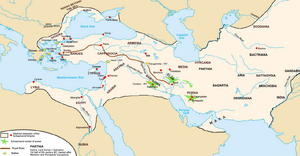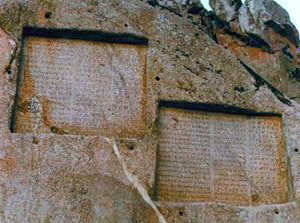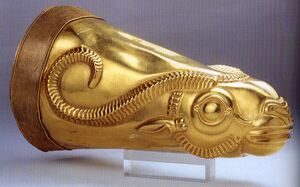Hamadan


Hamadan or Hamedan ( Persian: همدان , Old Persian: Hagmatana, Ancient Greek: Ecbatana, Kurdish: Ekbatan) is the capital city of Hamadan Province of Iran. It had an estimated population of 550,284 in 2005.[1]
Hamadan is believed to be among the oldest Iranian cities and one of the oldest in the world.
Hamadan is a green mountainous area in the foothills of the 3574-meter Alvand Mountain, in the midwest part of Iran. The city is 1850 meters above sea level.
The special nature of this old city and its historic sites attract tourists during the summer to this city, located approximately 400km southwest of Tehran.
History

According to an inscription from the first Assyrian king, Hamadan's construction is dated at 1100 BC, but some historians believe it dates back to 3000 BC.
Hamadan was established by the Medes and was the capital of the Median empire. It then became one of several capital cities of the Achaemenid Dynasty.
Hamadan is mentioned in the biblical book of Ezra as the place where a scroll was found giving the Jews permission from King Darius to rebuild the temple in Jerusalem. (Ezra 6:2). Its ancient name of Ecbatana is used in the Ezra text. Because it was a mile above sea level, it was a good place to preserve leather documents.
During the Parthian era, Ctesiphon was the capital of the country, and Hamadan the summer capital and residence of the Parthian rulers. After the Parthians, the Sassanids constructed their summer palaces in Hamadan. In the year 633 the battle of Nahavand took place and Hamadan fell into the hands of the Muslim Arabs.
During the Buwayhids , the city suffered much damage. In the 11th century, the Seljuks shifted their capital from Baghdad to Hamadan.
The city of Hamadan, its fortunes following the rise and fall of regional powers, was completely destroyed during the Timurid invasion. During the Safavid era the city thrived. Thereafter, in the 18th century, Hamadan was surrendered to the Ottomans, but due to the courage and chivalry of Nader Shah Afshar, Hamadan was cleared of invaders and, as a result of a peace treaty between Iran and the Ottomans, it was returned to Iran. Hamadan stands on the Silk Road, and even in recent centuries the city enjoyed strong commerce and trade as a result of its location on the main road network in the western region of Persia and Iran.
During World War I, the city was the scene of heavy fighting between Russian and Turko-German forces. It was occupied by both armies, and finally by the British, before it was returned to control of the Iranian government at the end of the war in 1918.
Climate
Hamadan province lies in a temperate mountainous region to the east of Zagros. The vast plains of the north and northeast of the province are influenced by strong winds, that almost last throughout the year. The various air currents of this region are: the north and north west winds of the spring and winter seasons, which are usually humid and bring rainfall. The west-east air currents that blow in the autumn, and the local winds that develop due to difference in air-pressure between the elevated areas and the plains, like the blind wind of the Asad Abad region.
Hamadan isin the vicinity of the Alvand mountains and has a cold, mountainous climate, with snowy winters. In fact, it is one of the coldest cities in Iran. The temperature may drop below -30°C on the coldest days. Heavy snowfall is common during winter and this can persist for periods of up to two months. During the short summer, the weather is mild, pleasant, and mostly sunny.
Culture
Hamadan is home to many poets and cultural celebrities. The city is also said to be among the world's oldest continuously inhabited cities.
Handicrafts: Hamadan has always been well known for handicrafts like leather, ceramic, and beautiful carpets.
Iran's Cultural Heritage Organization lists 207 sites of historical and cultural significance in the city of Hamadan alone.
Legend has it that the biblical Esther is buried in Hamadan.
The scientist and writer known in the west as Avicenna (Abu Ali Sina) is buried in Hamadan.
The 11th century Persian poet Baba Taher is also interred in Hamadan.
It is the birthplace of Badi` al-Zaman al-Hamadhani, author of the Maqamat.
Contemporary Culture and Extras
The residents of Hamadan are very proud of the town's historical heritage. Another source of their pride is Avicenna (aka Bouali, Buali, Ebn-e-sina, Pur-e-Sina) who is buried in Hamadan. Primary schools, high schools, and the main city's university are named after him. Even shops and businesses are named after him. Bouali Street is a very busy one and a favorite pastime of Hamadanians is to stroll up and down the street where they frequently bump into their acquaintances. The city has a population of over 600,000 including its outer suburbs. Hamadan is generally a prosperous town; the northern districts are mainly lower middle-class or working class residential areas.
References
Back to Silk Road/Back to Jat Places in Iran

